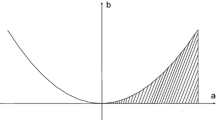Abstract
We consider the dynamics of an infinitesimal particle under the gravitational action of P primaries of equal masses. These move in an elliptic homographic solution of the P-body problem and the infinitesimal particle moves along the straight line perpendicular to their plane of motion and passing through the common focus of the ellipses. In this work we consider the parametric stability of the infinitesimal mass located at the focus of the ellipses. We construct the boundary curves of the stability/instability regions in the plane of the parameters \(\mu \) and \(\epsilon \), which are the mass of each primary and the eccentricity of the elliptic orbit, respectively.




Similar content being viewed by others
Notes
Consider a Hamiltonian function of the form \(H=H_{0}+\epsilon H_{1}+\epsilon ^{2} H_{2} + \mathcal {O}\left( \epsilon ^{3}\right) \) where \(H_{1}, H_{2}, \ldots \) are quadratic forms in the variables \(y_{1}, \ldots , y_{2n}\) with continuous \(2\pi \) periodic coefficients in t and
$$\begin{aligned} H_{0}=\frac{1}{2}\displaystyle \sum _{k=1}^{n}\sigma _k\left( y_{k}^{2}+y_{n+k}^{2}\right) , \quad \sigma _k=\delta _k\omega _k, \quad \text{ with }\ \ \delta _k=1 \ \text{ or } \ -1. \end{aligned}$$KGL Theorem: For sufficiently small \(\epsilon \) the linear system with the above Hamiltonian H is stable if and only if the quantities \(\sigma _{j}\) are not related by equalities of the form \(\sigma _{k}+\sigma _{l}=N\) where \(k,l=1, 2, \ldots \) and \(N=\pm 1, \pm 2, \ldots .\) By a “Krein resonance” we mean a resonance as in the statement of the theorem. Note that when \(n=1\) the only possible such relation is \(\sigma _{1}+\sigma _{1}=N,\) i.e., \(2\omega _1=N\).
References
Azevedo, C., Cabral, H.E., Ontaneda, P.: On the fixed homogeneous circle problem. Adv. Nonlinear Stud. 7(1), 47–75 (2007)
Markeev, A.P.: Linear Hamiltonian Systems and Some Applications to the Problem of Stability of Motion of Satellite Relative to the Center of Mass, p. 396. Nauka, Izhevsk, Moscow (2009) (In Russian)
Meyer, K., Hall, G., Offin, D.: Introduction to Hamiltonian dynamical systems and the N-body probem. Appl. Math. Sci. 90, 396 (2009)
Moser, J.K.: Stable and Random Motions in Dynamical Systems. Princeton Unversity Press, Princeton (1973)
Sitnikov, K.: Existence of oscillating motions for the three-body problem. Dokl. Akad. Nauk. USSR 133, 303–306 (1960)
Acknowledgments
The authors would like to thank Dieter Schmidt for discussions on our implemention of the algorithm to compute the coefficients of the stability curves and Lucas Valeriano Rezende for his help on the implemention of the calculations.
Author information
Authors and Affiliations
Corresponding author
Rights and permissions
About this article
Cite this article
Dias, L.B., Cabral, H.E. Parametric Stability in a Sitnikov-Like Restricted P-Body Problem. J Dyn Diff Equat 30, 81–92 (2018). https://doi.org/10.1007/s10884-016-9533-7
Received:
Revised:
Published:
Issue Date:
DOI: https://doi.org/10.1007/s10884-016-9533-7



